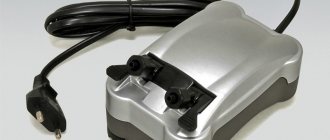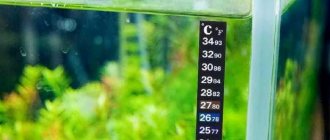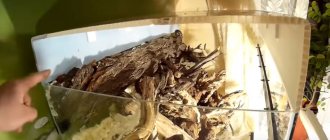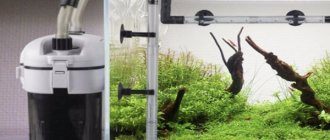Which soil is better to buy for an aquarium?
When choosing aqua soil, take into account, first of all, the needs of the fish, as well as the conditions created in the aquarium.
For example, the chemical composition of water:
- Marble and dolomite chips increase dGH, which is good for cichlids, but bad for gourami, zebrafish and some other fish.
- Anthracite makes the water more acidic.
- Crushed granite, quartz and artificial stone are neutral.
- A special nutrient soil softens and acidifies the water, stimulating plant growth.
The size of soil particles is determined by the species of plants and fish. The fine sand gets compacted and the roots rot in it. Due to poor water circulation, it “sours”, forming bubbles of methane and hydrogen sulfide.
Sand up to 0.5 mm in size is a decor that is not suitable for plants, but can be used in conjunction with coarse grains. A soil size of 1-2 mm is suitable for all small and medium-sized fish that sift the substrate through their gills.
3-5 mm soil is universal and suitable for most aquarium inhabitants. Pebbles larger than 5 mm are a suitable decoration for a pond with those inhabitants for whom the presence of an embankment is generally indifferent.
For tropical fish and fresh water, aqua soil in natural shades is better. Bright or light soil will make the fish appear duller - they will adapt to the environment.
There are also fake substrates - gravel painted in bright colors with waterproof construction paint. This is extremely dangerous! A fake can be identified by a strong odor, lack of markings and chipping coating.
How to make a samp
A homemade sump is much cheaper than other types of homemade filters. Moreover, during the construction process it is possible to improvise with liquid purification options, filter elements and substrates.
Sumps are very easy to maintain, but their full operation can only be ensured by proper installation of all the necessary parts, which requires effort and certain skills. However, once you understand the principle of operation of this biofilter, you will probably be able to make it yourself.
Materials and tools
For further work we will need:
- paper napkins (for degreasing glass);
- 4 corner holders;
- 5 wooden blocks (for installing aquarium glass) 15–20 cm high;
- clamps (for fastening angle holders);
- sealant;
- glass cleaning agent;
- spouts;
- end knife;
- blade;
- roulette;
- pencil (for marking);
- plastic stands (2 mm thick);
- electric gun;
- construction knife;
- pliers;
- glass at least 5 cm thick.
Step-by-step instruction
Before starting construction, you need to decide on the size of the future sump.
It is worth considering the following important nuances:
- the finished structure must correspond to the dimensions of the aquarium pipe;
- the structure should provide access to all its compartments;
- the biofilter must contain all the water that will drain from the aquarium in the event of a power outage and the pump stops.
Next we will talk about a structure with the following parameters:
- length - 650 mm;
- height - 330 mm;
- width of the first compartment - 120 mm;
- the width of the second and third compartments is 170 mm each;
- the height of all partitions between the compartments is 220 mm;
- the height of the indentation of the first partition is 20 mm.
Once you have the drawings and necessary parts ready, you can begin assembly.
How to make a samp with your own hands: video
Type and composition of soil for the aquarium
Bottom floorings can be divided into the following groups:
- natural (sand, crushed stone, pebbles);
- compositions based on natural materials obtained as a result of chemical or mechanical processing;
- artificial compounds.
Natural substrates
A fairly common option due to its attractive appearance, low cost, variety and chemical neutrality. Gravel, crushed stone and quartz sand are suitable in most cases, since they do not release harmful compounds into the water, while being an excellent environment for beneficial bacteria. This option is not the best for the development of underwater plants. It is recommended to use a natural substrate together with special substrates.
Advantages:
- ensuring water circulation;
- The pH reaction of the aquatic environment remains unchanged;
- ease of care;
- the ability to create beautiful three-dimensional compositions that look good from the outside;
- performance of biological function “excellent”;
- water purification effect (for example, shungite).
Minuses:
- large fractions are not suitable for fish that burrow deep into the ground. If you use fine sand, it will cake and sour over time;
- lack of nutrients for plants.
Natural substrate after processing
The most popular bedding in this category is expanded clay (fired clay). The material is natural and chemically neutral. The substrate, which is sold in specialized stores, is smooth and round. But there is also a drawback: the soil is fragile. As it breaks down, it pollutes the water. The “processed” category also includes colored dolomite, coral sand and glass. They do not have any advantages over natural stones, although they look quite beautiful.
Advantages:
- natural look (natural brownish tint);
- good circulation;
- excellent performance of biological function;
- chemical neutrality;
- the effect of destroying excess organic matter and fertilizers;
- ease of cleaning;
- rounded surface;
- porosity.
Minuses:
- strong destructibility;
- lack of nutrients in the composition;
- excessive lightness, the need for deep planting of certain types of algae.
Artificial mixtures
They look like brightly colored pebbles. The material used is glass or plastic chips. This option is suitable for all fish, with the exception of those that bury themselves in the sand (the same river stingrays). The advantages of artificial substrates include the following:
- the composition of the water remains unchanged;
- aesthetics;
- good water circulation;
- ease of care.
Minuses:
- reduced biological function due to lack of pores;
- unnatural appearance;
- unsuitability for planting.
The last drawback is mitigated by the use of nutrient substrates.
The best decorative soils for aquariums
This includes soils made of sand, gravel, polished and crushed rocks - that is, the usual river and lake substrate. For beauty, some manufacturers coat the grains with resins or enamel, which is safe for the inhabitants of the reservoir.
JBL Sansibar White (0.1-0.4 mm) – quartz sand
It is suitable for both aquariums and aquaterrariums because it is completely safe for aquatic life.
The grain fraction is 0.1-0.4 mm, a 5 kg package is enough for an aquarium of 12-25 liters. Sand can be used throughout the entire life of the aquarium. In addition, it forms a successful tandem with the JBL AquaBasis plus substrate.
Advantages:
- Non-toxic;
- Neutral with respect to the chemical composition of water;
- Does not require replacement;
- Snow-white shade;
- Completely ready to use.
Flaws:
- Not suitable for bottom heater.
The peculiarity of this sand is its fine fraction. This soil is ideal for freshwater and pseudo-marine artificial ponds with plants.
UDeco “White gravel”, natural (3-5 mm) – high-quality neutral soil
Gravel fraction – 3-5 mm. It is completely ready for use and is intended for aquariums from 25 liters, as well as terrariums and paludariums. It is supplied in packages of 6 liters (about 10 kg).
Advantages:
- Snow-white color without yellowness;
- One package is enough for a 15-liter aquarium;
- Homogeneous fraction;
- Suitable for African cichlids – slightly increases carbonate hardness;
- Not dyed - natural.
Flaws:
- It takes a long time to rinse because the gravel muddies the water.
The shrimp will be perfectly visible on the white crumbs, the fish will be contrasting, and the plants will be bright.
Dennerle Nano Garnelenkies (0.7-1.2 mm) – color palette of 9 shades
Natural quartz and gravel substrate designed for small aquariums. Its grain is round in shape, so it is not dangerous for fish living on the bottom. Gravel is resistant to CO2, lightfast and does not change the composition of water. Sold in 2 kg packs.
Advantages:
- Clean and does not require rinsing;
- Uniform granulometric composition;
- Safe for bottom fish and plants;
- Gives an unusual look to the aquarium;
- Does not increase water hardness.
Flaws:
- Microflora in such soil multiplies very slowly.
Nano Garnelenkies are so colorful that they are sure to attract attention. And the price for it is quite reasonable.
ArtUniq Color – the widest selection of colors
One two-liter package of this soil is enough for a 15-liter aquarium. Its particle size is 1-2 mm. An artificial pond with it looks very unusual.
ArtUniq Color allows the aquarist to use his imagination and create a unique landscape on the bottom using granules of different colors.
Advantages:
- Affordable price;
- 12 different shades that can be mixed;
- Does not affect the composition of water;
- Polished surface;
- Sold in packs of 2 and 6 liters.
Flaws:
- It is necessary to separately purchase a nutrient substrate for planting plants.
ArtUniq Color is ready for use. However, before adding it to the aquarium, it is recommended to rinse it thoroughly with water.
Marine ready-made branded aquarium complex
Some aquarists who decide on a marine aquarium purchase ready-made aquarium complexes, such as Reef Max, Elos, Blau, Sera Marin Biotop and their cheaper analogues, usually made in China, designed for keeping marine life. To some extent, this is a justified decision and that’s why, having bought a ready-made marine aquarium complex, you receive the necessary set ready for launch, there is no need to rack your brains about what equipment to buy, what kind of light, etc., the manufacturers have already thought of everything for you.
Marine aquarium complex with display
In the video, the complete set of the finished Red Sea MAX marine complex shows the technical compartment (sapm) located behind the back wall of the aquarium. The video is without translation, but the meaning is clear.
And here is the ready-made Red Sea MAX S series aquarium complex. In this version, the sump is located in the cabinet under the aquarium. Another video of the already developed Red Sea MAX 250 marine aquarium. The models of ready-made complexes have a good appearance and fit well into the interior. Cons, of course the price, branded aquarium complexes are not cheap, as in general everything related to marine aquarium keeping. The second point is that during the operation of such complexes, the aquarist gradually comes to the conclusion that I would change this, redo this, and here I would install other equipment. And a large number of such “here” and “here” accumulate and the aquarist, who has already gained some experience, begins to customize the complex for himself, trying to improve the basic configuration. And ultimately he comes to the conclusion that it would be nice to make a new marine aquarium that fully meets his requirements.
Custom marine system assembly
Sooner or later, an understanding comes of how a proper marine system should look and function (everyone has their own opinion here) and a choice is made in favor of organizing a custom-made marine aquarium. That is, you either yourself or using the services of private craftsmen or companies design an aquarium, sump, overflow system, cabinet, and then select equipment, lighting, flow system, foam tank, etc. The result is a marine aquarium that meets all your needs . Probably, even if, for example, you glue the aquarium and sump yourself, provided that you can do it, and also assemble the cabinet (stand) yourself, it will be cheaper than ready-made aquarium complexes of the same volume. Some go further and assemble lighting for the aquarium on their own, for example making LED lighting, although this requires technical skills.
Which path to take is up to you to decide; all three options, as they say, are working and everyone here chooses based on personal preferences and capabilities.
The best nutrient soils for aquariums
This is a specialized substrate containing many nutrients and microelements for better plant growth. It is used in natural aquariums and is capable of changing the hydrochemical composition of water.
Aquayer 1 (AQY-PP15) – stress-free plant replanting
One package of such soil weighs 0.70 kg (1.5 liters) - it is enough for a container of 25-50 liters. Feeding with a rich composition accelerates the growth of plants and promotes their rooting. It simplifies starting an aquarium and replanting vegetation.
Advantages:
- Favorable acidity – pH 6.5-6.8;
- Effective throughout the entire period of operation of the aquarium;
- Prevents souring due to the porous structure;
- Prevents the appearance of unwanted algae.
Flaws:
- Without the supply of CO2, it can “foul.”
With nutritious Aquayer soil, aquatic plants grow healthy, lush and strong.
Dennerle DeponitMix Professional 9in1 – primer with a rich composition
This fertilizer is sold in 4.8 kg buckets. One package is enough for an aquarium of 100-140 liters. The mixture is ready to use. It contains natural peat, natural clay, mineralized soil, chelated iron and biofiltration granules.
The circulation of water in the substrate is slowed down by lime-free quartz sand. With it, roots grow better and plant foliage becomes lush.
Advantages:
- Safe for any aquarium inhabitants;
- The mixture is wet, so bacteria are always active in it;
- The composition contains biodegradable granules that improve the development of beneficial microflora;
- Prevents the development of unwanted algae.
Flaws:
- Used only as a substrate for decorative primer.
This fertilizer improves the microflora of the aquarium, but due to the small size of the particles, it cakes and sours in the lower layers over time. It will also not be possible to use it as an independent soil.
ADA Power Sand Advance – aquarium starting kit
The substrate is enriched with ADA Bacter and ADA Clear Super additives, containing preserved microorganisms. It also contains the plant growth stimulator Tourmaline BC.
The porous structure ensures good water circulation and is an ideal environment for the development of organic matter and beneficial bacteria. Granules are sold in three sizes: S, M, L.
Advantages:
- Contains mineral fertilizers;
- Creates a nutrient medium for shrimp;
- Long-lasting effect of purifying water from harmful substances;
- Ensures good fluid circulation;
- Stimulates the development of flora.
Flaws:
- Over time, it forms dust that is difficult to remove.
This super nutritious substrate does not need to be washed before adding to the aquarium. However, a bottom heater cannot be used with it.
Smooth balls with a fraction of 2-4 mm are used for breeding aquarium plants and creating a nutrient medium for shrimp. The soil is sold in packs of 3 kg.
Gloxy GL-563509 (2-4mm) – beige nutrient soil
Smooth balls with a fraction of 2-4 mm are used for breeding aquarium plants and creating a nutrient medium for shrimp. The soil is sold in packs of 3 kg.
Advantages:
- Has acidity suitable for vegetation and shrimp;
- Maintains biobalance in the aquarium;
- Softens water;
- It has a loose structure in which anaerobic bacteria actively develop;
- The interesting shape of the granules attracts attention.
Flaws:
- Quite a high price for 3 kg - 1100 rubles.
Gloxy helps maintain a stable, healthy composition of water in the aquarium and removes suspended matter well.
We assemble the samp with our own hands
We will assemble the cleaner from “available” materials. You'll need:
- Watering hoses - 2 meters.
- Connecting couplings - 2 pcs.
- Plugs - 5 pcs.
- Silicone sealant.
- Sewer pipes D=110 and L=1000.
- Mayevsky crane.
- Clutch D=110.
- Pump (Barbus Qmax=600 l/h, H=1.0 m).
How the device works
First, measure the height and width of the niche under the aquarium.
For example, a filter height of 50 cm is required. We measure the required pipe length and cut it (taking into account the height of the coupling). We remove the plugs with a knife and get 3 disks. These will be the filter element separators. We drill two identical holes in the plug for connecting couplings and a hole for the pump wire. To pass the pump wire through the plug, you will have to cut it. At the same stage we install the switch.
Sump tanks
We install hose connectors and a valve to eliminate air pockets. Apply glue along the joints and leave the parts until completely dry.
While the glue hardens, we assemble the case and check the tightness without using silicone. Fill it completely with water and leave for 10-12 hours. Now let's put the parts together. Schematically, the design should look like this:
Sump circuit
The blue parts are the water inlet and outlet tubes. Our filter has 3 compartments (you can make more): a large sponge, medium-sized expanded clay, and a small sponge. The finished product looks like this:
Ready samp
Assembly recommendations:
- Don't skimp on sealant.
- Check the couplings directly in the store. The petals that compress the hose are plastic. If someone had already “tested” them for effectiveness, they might have broken them.
- Install a coarse filter on the water intake hose. This will help prevent small fish, algae and pebbles from being sucked in.
- Expanded clay can be replaced with ceramic filler.
To start the filter, you must first fill it with water.
Installing a drain hole and rules for drilling glass
When installing a sump, a drainage device (overflow shaft) is additionally installed. It is connected to the bottom or side of the aquarium.
DIY samp
Installing a drain hole involves drilling the tank.
To avoid damaging the glass, follow the recommendations:
- Perform work at minimum drill speed.
- Use a diamond-tipped drill bit.
- Hold the tool at a right angle.
- Add water to the drilling area from time to time. This will help soften the drill stroke.
- Work without effort or pressure.
Some useful tips
They will help a beginner to accurately select the appropriate option from a large number of proposals:
- White stones are impractical. They look great at first, but over time they darken or take on a greenish tint from the plants;
- The thickness of the soil layer must be sufficient. On average, it is 50-70 mm;
- small stones are suitable for small fish. If the size of the pets is large enough, it is advisable to purchase large soil (it is also taken into account that the inhabitants of the aquarium can grow over time);
- Quartz is a good choice for beginners because it combines practicality and neutrality. Plus, it looks just great;
- for an aquarium with bright tropical fish (barbs, cockerels, male guppies), it is advisable to use a substrate of natural shades or black. Against the background of too light or brightly colored soil, the fish will fade as they try to blend in with their environment.
The rules are quite simple, but following them will help avoid many problems.











